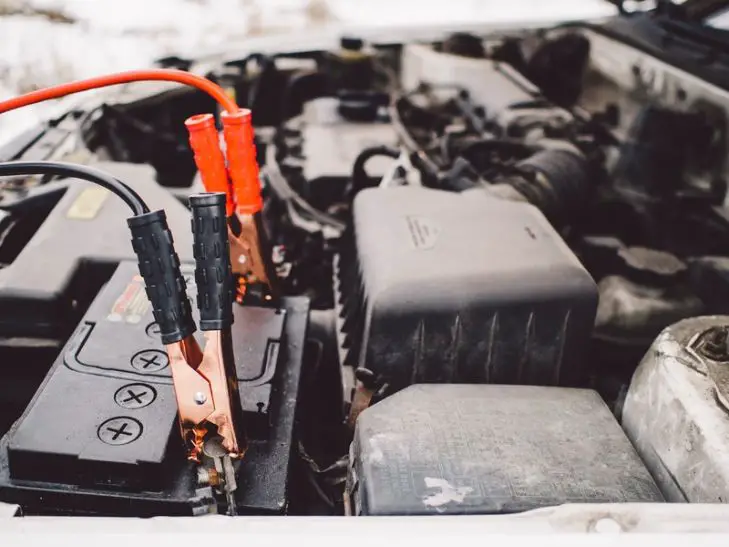Battery terminal corrosion is common in car batteries. But do you know what causes car battery corrosion on positive terminal?
The main reason is overcharging. It introduces rust to the positive terminal. Nevertheless, some mutual reasons cause corrosion on both terminals.
In this article, I am going to describe all those causes along with the prevention technique, and how to keep it clean from rust. The discussion will help you maintain the batteries and ensure optimum performance.
So, What Causes Car Battery Corrosion on Positive Terminal?
According to the experts, overcharging is the sole cause of positive terminal corrosion at the contact point.
And, a greenish-blue slug is the sign of the problem. However, the color of the corrosion can be changed depending on the terminal material.
Here, greenish-blue indicates a pile-up of copper sulfate. I am assuming the terminals are made of copper which reacts to the lead in the battery.
For the batteries with an aluminum terminal, you will see whiter corrosion which indicates aluminum sulfate.
Too much corrosion can lead to serious problems. Your car may not even start in the most severe situations.
Now, you should know other less obvious battery terminal corrosion causes. I am saying less noticeable because they are the signs of corrosion on both terminals.
- Gas leakage is one of the most common reasons for rust buildup. When the hydrogen gas in the battery finds a way out, it starts reacting with other substances close to it.
- Another common complaint from the users is the electrolyte leakage in a lead-acid battery. It can happen due to external damage, aging, or overfilled water.
- Usually, copper terminals do not corrode easily. But that characteristic gets altered when high-current is passing through the material. Thus, corrosion occurs.
How to Prevent Positive Terminal from Getting Corroded?
There are several cost-effective and easy methods to prevent battery terminal corrosion. Let me tell you the most effective ones below.
1. Don’t Overcharge
You have probably guessed this solution by reading the problem described above.
Not overcharging is the first step to ensure zero corrosion.
I have seen lots of high-tech chargers on Amazon that show the amount of juice in the battery and when to stop charging it.
Investing a little more in high-quality products will ensure the optimum health and performance of your expensive car battery.
2. Use Anti-corrosive Sprays
Read the owner manual or search online to find out the right kind of spray for preventing corrosion.
You can find the products in your local retail superstores or online platforms. The chemicals are very effective among all methods.
However, you should keep the battery in check every few months to be safe than sorry.
3. Use Petroleum Jelly
You will be surprised to know that petroleum jelly also does a great job at keeping the terminals safe.
Take about a tablespoon of petroleum jelly and apply it to each terminal for the best and long-lasting protection.
One must take the battery out of the car mount to apply to avoid any possibility of missing a spot.
4. Use Dielectric Grease
Another expert-suggested method is to apply dielectric grease. Like petroleum jelly, it is a good protector of the metal terminals.
I think that it is even better but some people are not willing to pay more. That is why I have suggested petroleum jelly first.
5. Don’t Discharge Completely
Besides the warning of overcharging, experts also recommend owners not drain the battery thoroughly.
Both are harmful to batteries and can take a toll on the terminals.
6. Visual Check
The final suggestion from my end is to perform visual inspection regularly to detect buildups at the early stage.
This way, you can take action before things get too nasty or problematic. Moreover, don’t forget to have a quick look into the battery cables.
What Are the Effects of Positive Terminal Corrosion?
Battery plays one of the most important roles in a vehicle.
From starting the engine to smooth running and operating different electronics, having a consistent supply of electricity is a must.
But the heavily corroded positive terminal can affect the entire electrical system in a car or truck or other vehicle.
With mildly affected terminals, you may notice that some of the mechanisms are not acting normally.
You may see that the headlight has suddenly started fading or flickering. Also, the audio quality may degrade or the dashboard can grow dim.
In severe situations, your car won’t start at all.
How to Clean Corroded Car Battery Positive Terminal?
Using either Coca Cola or baking soda-water solution, you can easily clean a corroded terminal within a few minutes.
Here’s how to do it in a proper way.
Firstly, mix one tablespoon of baking soda into one pint of water.
Then, use an old toothbrush to apply the mixture to the terminals.
Here, you have to scrub thoroughly to clean it perfectly.
Tip: Take the battery out so that you don’t miss any spot.
After that, wipe the terminals and clamp with a clean rug making sure that there is no residue.
Next, use a terminal brush to clean the connections thoroughly removing rust or corrosion completely.
Finally, do the rinsing and cleaning with soda water one more time, clean the residue, and reinstall the connections.
Those who are wondering how to use cola should follow the same procedure. The only difference is that you have to use clean water after using cola.
Verdict
Now you know what causes car battery corrosion on positive terminals.
I hope that you will take the preventive measures seriously because the battery is a crucial part of your car.
Related Posts:

